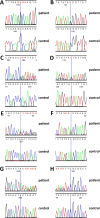Five novel CNGB3 gene mutations in Polish patients with achromatopsia
- PMID: 25558176
- PMCID: PMC4279706
Five novel CNGB3 gene mutations in Polish patients with achromatopsia
Abstract
Purpose: To identify the genetic basis of achromatopsia (ACHM) in four patients from four unrelated Polish families.
Methods: In this study, we investigated probands with a clinical diagnosis of ACHM. Ophthalmologic examinations, including visual acuity testing, color vision testing, and full-field electroretinography (ERG), were performed in all patients (with the exception of patient p4, who had no ERG). Direct DNA sequencing encompassing the entire coding region of the CNGB3 gene, eight exons of the GNAT2 gene, and exons 5-7 of the CNGA3 gene was performed. Segregation analysis for the presence and independent inheritance of two mutant alleles was performed in the three families available for study.
Results: All patients showed typical achromatopsia signs and symptoms. Sequencing helped detect causative changes in the CNGB3 gene in all probands. Eight different mutations were detected in the CNGB3 gene, including five novel mutations: two splice site mutations (c.1579-1G>A and c.494-2A>T), one nonsense substitution (c.1194T>G), and two frame-shift mutations (c.393_394delGCinsTCCTGGTGA and c.1366delC). We also found three mutations: one splice site (c.1578+1G>A) and two frame-shift deletions that had been previously described (c.819_826del and c.1148delC). All respective parents were shown to be heterozygous carriers for the mutation detected in their children.
Conclusions: The present study reports five novel mutations in the CNGB3 gene, and thus broadens the spectrum of probably pathogenic mutations associated with ACHM. Together with molecular data, we provide a brief clinical description of the affected individuals.
Figures



References
-
- Kohl S, Jägle H, Sharpe LT, Wissinger B. Achromatopsia. GeneReviews™. University of Washington, Seattle. 1993-2004 - PubMed
-
- Kohl S, Marx T, Giddings I, Jagle H, Jacobson SG, Apfelstedt-Sylla E, Zrenner E, Sharpe LT, Wissinger B. Total colour blindness is caused by mutations in the gene encoding the alpha-subunit of the cone photoreceptor cGMP-gated cation channel. Nat Genet. 1998;19:257–9. - PubMed
-
- Kohl S, Baumann B, Broghammer M, Jagle H, Sieving P, Kellner U, Spegal R, Anastasi M, Zrenner E, Sharpe LT, Wissinger B. Mutations in the CNGB3 gene encoding the beta-subunit of the cone photoreceptor cGMP-gated channel are responsible for achromatopsia (ACHM3) linked to chromosome 8q21. Hum Mol Genet. 2000;9:2107–16. - PubMed
-
- Thiadens AAHJ, den Hollander AI, Roosing S, Nabuurs SB, Zekveld-Vroon RC, Collin RW, Baere ED, Koenekoop RK, van Schooneveld MJ, Strom TM, van Lith-Verhoeven JJC, Lotery AJ, van Moll-Ramirez N, Leroy BP, van den Born LI, Hoyng CB, Cremers FPM, Klaver CCW. Homozygosity mapping reveals PDE6C mutations in patients with early-onset cone photoreceptor disorders. Am J Hum Genet. 2009;85:240–7. - PMC - PubMed
Publication types
MeSH terms
Substances
LinkOut - more resources
Full Text Sources
Medical

